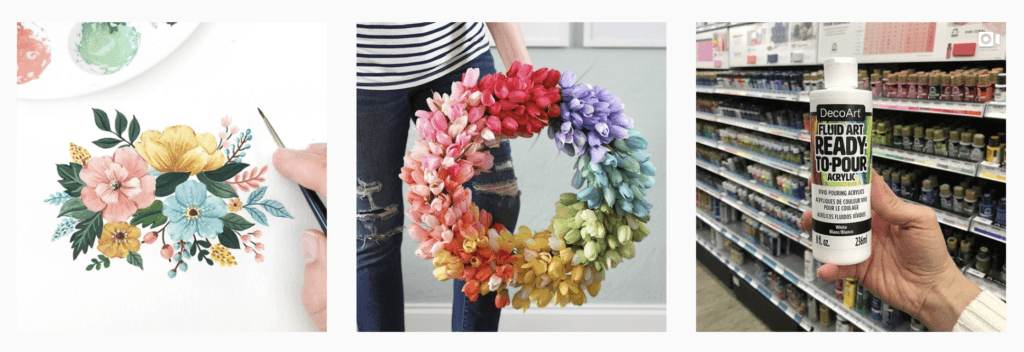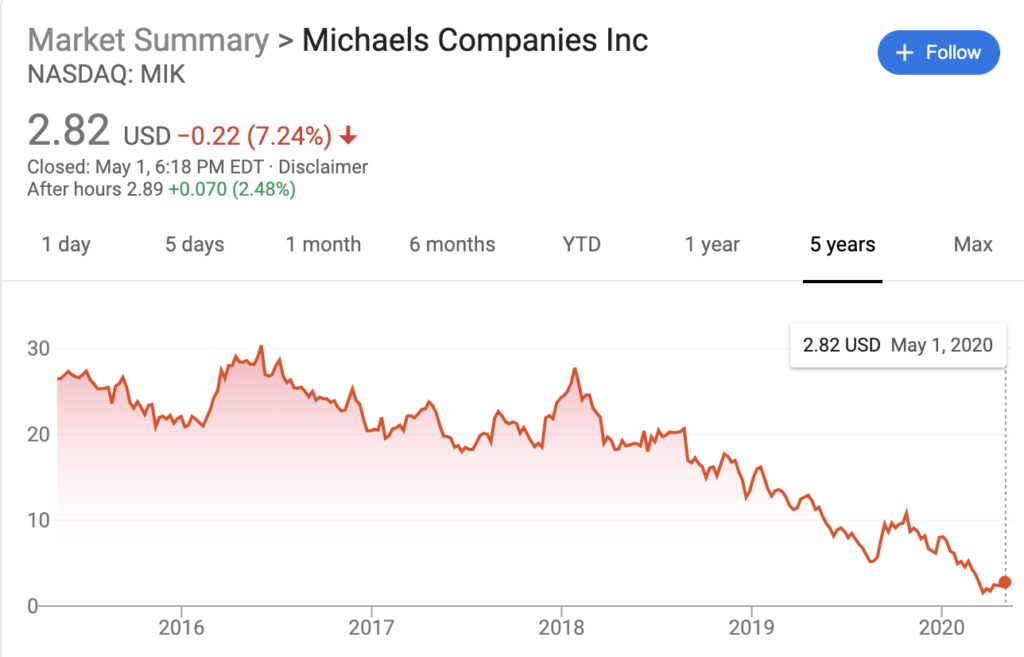Michaels: The Arts & Crafts Retailer Struggling to Stay Afloat

The brick-and-mortar retailer is facing large sales declines due to a slow roll out of their e-commerce efforts.
Like many brick-and-mortar retailers, Michaels (NASDAQ:MIK) faced years of declining sales prior to COVID. Its stock had dropped over 65% from the beginning of 2018 to the beginning of 2020, as consumers shifted to online shopping from larger players, such as Amazon, or discounters such as Walmart and Dollar Tree.
Michaels’ online presence was minimal, with inventory on the website not always up to date and delivery times quite slow. Their e-commerce channel represented less than 5% of sales, a result of management’s lack of direction and push when it came to developing an online presence.
COVID response
Staying Open
With the rise of COVID in February 2020, the retail landscape is being challenged during these unprecedented times. As governments across the world resort to shelter-in-place orders, stores deemed non-essential are asked to close down. Where does Michaels fare on this list? Management insisted that they’re an essential store, offering communities hobbies to take their minds off of the crisis and improve their mental health. While a few local governments across the US have mandated that Michaels close shop for the duration of the crisis, the majority of them are still open.
Upping Their Social Media Game
An update of their website was the next step, including a message to consumers about their stance on COVID, incredible deals of up to 70% select items, and links to social media pages. They’ve also added new blog posts and product bundling targeting families and children in self-isolation. Their Instagram page (@michaelsstores) – with over 1.5M followers – began offering curated COVID content and promoting their #MakeItWithMichaels hashtag as a way to build word-of-mouth and create excitement and engagement within the community.
Delivery and Pick Up
A partnership with UPS has allowed Michaels to begin offering same-day delivery to its customers – an upgrade they hope will boost e-commerce sales. They have similarly began offering curbside pickup where an employee delivers your order to your car, just hours after having placed an online order. With contactless delivery and pick up being rolled out in over 10 states, their efforts to retain customers and earn revenue appear to be the right decisions for such a store to stay relevant both in the digital revolution we are experiencing this decade, and amidst the coronavirus outbreak.
Looking Ahead
While their efforts to pivot from brick-and-mortar to online has seemed valiant, the numbers say otherwise. A look their stock in these past numbers shows a steep decline, from over $8.10 per share in January to $2.82 per share in May, suggesting that despite their digital innovation efforts, the company is struggling. It is hard to know whether their decline in performance is due to a struggling company about to go under or simply a response to the tough financial landscape COVID has set out for traditional retailers. I would argue that their slow build-up of an omnichannel presence came too late and with not enough drive from management.
Amazon, who entered the retail landscape over two decades ago, has slowly begun introducing more arts and crafts materials and providing shorter delivery times for their products. It is possible that Michaels is simply a casualty of the ‘retail apocalypse’ so many people are seeing as other online tech companies grow bigger and stronger.
Generalizable Lessons
While it is no surprise that traditional retailers are suffering worldwide, some have managed to maintain a foothold in the economy and not suffer as significant losses as the others. In Michaels case, it took a global pandemic to really kick-start their ecommerce platform and incentivize them to take the digitalization of their services seriously. In order to stay relevant in the market, brick-and-mortar shops are going to have to learn to go above and beyond simply selling products to customers in order to increase sales and maintain a loyal customer base. In Michaels case, I believe consultation on art projects as well as bundled do-it-yourself (DIY) kits are their differentiating factor from competitors like Amazon. Rather than resorting to constant sales of up to 70% off, they should leverage their skills and knowledge in the art space to offer personalized advice.
What Can They Do to Stay Relevant?
Beyond offering customers one-on-one consultations and package deals on products, they should consider partnering with local artists to provide step-by-step tutorials, masterclasses, or interactive online Zoom workshops through Michaels’ social media pages.
All across the globe, these tactics have been employed in traditionally non-digital industries to attract customers and maintain a steady stream of revenue. A barber shop in Tokyo, for example, has begun offering guided haircuts for men through video conference (called telecut), helping them stay afloat and helping their clients feel comfortable cutting their own hair during the pandemic. Not only is this helping the company gain some press, it is showing that even the smallest of organizations can stay innovative and bring a community together.
For Michaels, the task at hand is similar. People in quarantine across the globe are already turning to arts and crafts (as well as cooking and baking) to pass the time. The demand exists, and it is up to Michaels to supply the content that people are hungry for. I believe Michaels should be using this pandemic to reflect on past successes and failures, and devise a strategy to stay relevant and sought after moving forward.
Sources
- https://seekingalpha.com/article/4341543-michaels-boom-post-coronavirus-long-term-challenges-remain
- https://www.michaels.com/projects/10-items-for-100-projects/ten4onehundred
- https://www.fool.com/investing/2020/04/27/what-sent-these-consumer-goods-stocks-soaring-mond.aspx
- https://www.fool.com/investing/2020/04/29/near-an-all-time-low-is-michaels-a-buy.aspx
- https://www.instagram.com/michaelsstores/
- https://www.marketwatch.com/story/ups-partners-with-michaels-for-contactless-package-pickup-and-returns-2020-04-29?siteid=yhoof2&yptr=yahoo
- https://finance.yahoo.com/news/bear-day-michaels-mik-100010793.html







Thanks for sharing! I am impressed that Michael’s has adapted its business so quickly to begin offering online orders and curbside pick-up, especially considering it has traditionally been a fairly old-fashioned retailer. I would be interested to see if Michael’s has seen an increase in sales due to customers picking up more crafting during COVID-19 since people have a lot more time on their hands. I think it would be difficult to keep customers engaged in crafting post-COVID since people’s lives will fill up with their prior activities, leaving little time to dedicate to crafting. Michael’s may be able to keep people engaged by creating crafting workshops that continue post-COVID or posting nostalgic posts on social media about when people had time to craft during social distancing to reignite the interest in crafting.
Great post! I think this definitely could be an opportunity for Michael’s as people have more time on their hands for crafts now, but I worry about the lack of differentiation compared to big e-commerce players like Amazon. I used to go to Michael’s quite often and relied heavily on the knowledge of the staff to guide my purchases, so it seems like there could be an opportunity to leverage their expertise and potentially build an online community drive engagement. However, since digital isn’t really in Michael’s DNA I think they may need to bring on new talent and initiate more fundamental changes to their business model to take advantage of these opportunities.